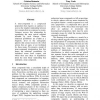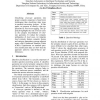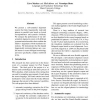COLING
2008
14 years 1 months ago
2008
In this paper, we consider classifying word positions by whether or not they can either start or end multi-word constituents. This provides a mechanism for "closing" cha...
COLING
2008
14 years 1 months ago
2008
We present an approach to ontology population based on a lexical substitution technique. It consists in estimating the plausibility of sentences where the named entity to be class...
COLING
2008
14 years 1 months ago
2008
A noun-compound is a compressed proposition that requires an audience to recover the implicit relationship between two concepts that are expressed as nouns. Listeners recover this...
COLING
2008
14 years 1 months ago
2008
We present an automatic method for senselabeling of text in an unsupervised manner. The method makes use of distributionally similar words to derive an automatically labeled train...
COLING
2008
14 years 1 months ago
2008
We study the self-organization of the consonant inventories through a complex network approach. We observe that the distribution of occurrence as well as cooccurrence of the conso...
COLING
2008
14 years 1 months ago
2008
Classifying what-type questions into proper semantic categories is found more challenging than classifying other types in question answering systems. In this paper, we propose to ...
COLING
2008
14 years 1 months ago
2008
Almost all automatic semantic role labeling (SRL) systems rely on a preliminary parsing step that derives a syntactic structure from the sentence being analyzed. This makes the ch...
COLING
2008
14 years 1 months ago
2008
The state-of-the-art system combination method for machine translation (MT) is the word-based combination using confusion networks. One of the crucial steps in confusion network d...
COLING
2008
14 years 1 months ago
2008
Most work on unsupervised entailment rule acquisition focused on rules between templates with two variables, ignoring unary rules - entailment rules between templates with a singl...
COLING
2008
14 years 1 months ago
2008
We present a sub-sentential alignment system that links linguistically motivated phrases in parallel texts based on lexical correspondences and syntactic similarity. We compare th...



